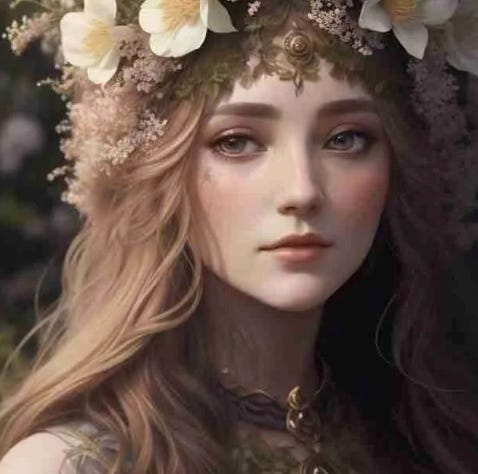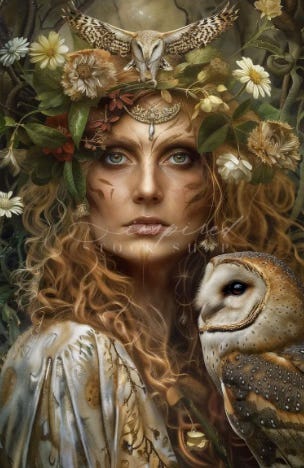The Celtic Goddess of Transformation and Identity
In the rich tapestry of Celtic mythology, Blodeuwedd stands out as a figure of transformation, identity, and the intricate interplay between the natural and supernatural worlds.
As a goddess woven from flowers and associated with spring, she embodies the beauty and complexity of life while also reflecting the darker themes of autonomy and destiny.
We will explore the origins, symbolism, and narratives surrounding Blodeuwedd, revealing her significance within the broader context of Celtic mythology and culture.
Origins and Mythical Narrative
Blodeuwedd, meaning "flower face" in Welsh, is most prominently featured in the "Mabinogi," a collection of medieval Welsh tales that form a crucial part of the Celtic mythos.
Her story begins with a male figure named Lleu Llaw Gyffes, the son of the mighty king Arawn and the goddess Aranrhod. Due to a series of unfortunate circumstances and a curse upon Lleu, he is destined never to have a human bride. In the act of intervention, his mother creates Blodeuwedd from the blossoms of oak, broom, and meadowsweet, imbuing her with life and beauty, thus representing the idealized and harmonious aspects of femininity.
Blodeuwedd's initial purpose is to serve as Lleu's wife, a relationship that, on the surface, embodies love and companionship. However, her narrative takes a poignant turn as she becomes aware of her confinement and the limitations imposed upon her. Attracted to a warrior named Gronw Pebr, Blodeuwedd's journey evolves into a tale of awakening and rebellion against the constraints of her existence. Her choice to pursue her desire leads to tragic consequences, ultimately reflecting the themes of choice, consequence, and identity.
Symbolism and Themes
Blodeuwedd is intrinsically linked to the natural world, her essence rooted in the flora that serves as her origin. This connection to the earth embodies themes of fertility, growth, and the cyclical nature of life.
As a goddess of spring, she symbolizes renewal and the transient beauty of life. Yet, unlike other deities who embody solely positive attributes, Blodeuwedd's story is a cautionary tale entwined with darker themes of betrayal and vengeance.
One of the most compelling aspects of Blodeuwedd's narrative is the exploration of autonomy. Created to fulfil a specific role, she grapples with the limitations placed upon her by the whims of others. Her transformation from a being fashioned for the desires of men into an agent of her fate illustrates a powerful journey toward self-discovery. This theme resonates deeply in modern contexts where the struggle for autonomy and identity remains pertinent, particularly in discussions surrounding gender roles and expectations.
The metamorphosis of Blodeuwedd is not just a physical one but a spiritual awakening as well. As she realizes her desires and seeks to break free from her constraints, she symbolizes the complex nature of identity influenced by external pressures and internal aspirations. Her choice to engage in a relationship with Gronw Pebr is a metaphor for defiance against societal norms and the quest for personal freedom. However, this pursuit of autonomy does not come without a price, highlighting the duality of freedom as both liberating and isolating.
Tragic Consequences and Transformation
The unfolding of Blodeuwedd's tale culminates in tragedy. After entering into an affair with Gronw, the two conspire to rid themselves of Lleu. Their actions lead to Lleu's near-death experience, marking a pivotal moment that transforms their lives irrevocably. When Lleu is ultimately restored through the intervention of powerful magic, he exacts a brutal form of justice. Blodeuwedd is punished for her betrayal and is condemned to become an owl, a creature often associated with dark omens and the night.
This metamorphosis serves as a profound commentary on the consequences of choice and the complexities of identity. As an owl, Blodeuwedd embodies the wisdom of experience and the sorrow of lost freedom. Her transformation signifies not just a punishment but a profound change in her essence, emphasizing that one's identity is not static but is shaped by actions, choices, and experiences.
Legacy and Cultural Significance
Blodeuwedd's legacy endures in various forms within contemporary culture, where she is often invoked as a symbol of female strength and resilience. Her story prompts reflection on the nature of love, loyalty, and the cost of autonomy. In the artistic realm, Blodeuwedd's character has inspired countless interpretations in literature, painting, and performance, each reflecting the evolving perceptions of femininity and the complex interplay between nature and humanity.
In modern feminist discourse, Blodeuwedd's narrative is a powerful allegory for women's struggle against patriarchal constraints. Her journey emphasizes the importance of agency and the need to carve out one's identity in the face of societal expectations. By reclaiming her narrative, Blodeuwedd serves as a beacon for those who seek to break free from the confines of traditional gender roles, illustrating the ongoing journey toward self-determination and empowerment.
Her association with nature also speaks to contemporary ecological themes, reminding us of the deep connection between identity and the environment. As a goddess born of flowers, Blodeuwedd embodies the fragility of life and the urgent need to honour the earth. In an age where environmental concerns are paramount, her symbolism encourages a dialogue about sustainability and our shared responsibility to protect the natural world.
The duality of Blodeuwedd's existence—her creation from beauty and her transformation into an owl—mirrors the complexities of contemporary identity. Just as she navigates the balance between love and betrayal, autonomy and consequence, modern individuals grapple with multifaceted identities shaped by culture, personal experiences, and societal norms. This duality allows Blodeuwedd to remain relevant, resonating with those who find themselves amid their transformations, whether through personal growth, cultural shifts, or social movements.
In conclusion, Blodeuwedd emerges not only as a figure of beauty and transformation but also as an embodiment of the struggles inherent in the quest for self-identity and autonomy. Her story serves as a reminder of the intricate ties between choice and consequence, the interplay of the natural and supernatural, and the enduring quest for personal freedom. Within mythology, her legacy inspires challenges and provokes thought, encouraging a deeper understanding of the human experience's complexities. As we reflect on her journey, we are invited to explore our transformation paths, embracing the beauty and challenges of the pursuit of authentic identity.
Blodeuwedd's tale invites us to delve deeper into the realms of mythology and the essential aspects of our contemporary lives. Her story prompts us to confront the societal confines that often script our identities, urging us to question and redefine who we are in light of our desires and ambitions.
Intersection of Mythology and Modernity
In our modern context, the themes woven into Blodeuwedd’s narrative resonate with emerging discussions around identity politics, self-definition, and the reclamation of personal agency.
The questions she raises, “What does it mean to be free?” and “How do we navigate the expectations imposed upon us by society?” remain relevant today. Women and marginalized groups, in particular, find in Blodeuwedd’s struggles parallels to their own battles against systemic constraints, making her a powerful symbol of resilience in the face of adversity.
Moreover, her transformation into an owl—a creature typically associated with wisdom and insight—serves as a metaphor for the growth that often emerges from hardship. Through her punishment, Blodeuwedd is transformed, yet she retains her essence; this duality presents a poignant reminder that even through suffering and loss, there can be an evolution of self. In contemporary discussions, this can represent the journey toward self-acceptance and the recognition that our past experiences, both joyous and painful, shape who we become.
Blodeuwedd in Art and Literature
Blodeuwedd's legacy has also found expression in various art forms, including literature, poetry, and visual arts. Contemporary writers and artists draw upon her myth to explore femininity, empowerment, and transformation themes. For example, retellings of her story often emphasize her agency and the reclamation of her narrative, providing a voice to those who have historically been silenced. By reinterpreting Blodeuwedd’s journey, modern creators contribute to a larger conversation about the need for diverse narratives that honour the complexities of human experience.
In visual arts, representations of Blodeuwedd often highlight her connection to nature, using floral motifs to symbolize her beauty and tragic fate. Artists may depict her surrounded by blooming flowers, a visual testament to her dual role as both a goddess of nature and a figure marked by loss. These artistic interpretations encourage viewers to reflect on the delicate balance between beauty and sorrow, reminding us that life is often a tapestry of both experiences.
Lessons on Identity and Transformation
As individuals today navigate a world marked by rapid change, technological advancements, shifting societal norms, and a growing awareness of diversity in identity—Blodeuwedd’s story offers valuable insights into the transformation process. The goddess’s journey underscores the importance of adaptability and resilience. In a landscape where identities are constantly evolving, embracing change can lead to profound growth and self-discovery.
The lessons gleaned from Blodeuwedd encourage individuals to confront societal expectations and find the courage to assert their true selves. In her narrative, we see the struggle for self-definition in stark relief, reminding us that the quest for identity often involves navigating societal pressures and personal desires. As Blodeuwedd recognizes her worth beyond the confines of her origins, individuals today are similarly urged to acknowledge their unique experiences and perspectives as integral to the tapestry of their identities.
In addition to personal transformation, Blodeuwedd’s story invites reflection on communal identity. As she evolves in response to her circumstances, so do communities reshape themselves in the face of challenges. The collective journey toward equity, inclusion, and representation parallels Blodeuwedd’s evolution, emphasizing the need for solidarity and mutual support in striving for greater societal autonomy and understanding.
Furthermore, Blodeuwedd’s association with the cycle of nature reminds us of our interconnectedness with the environment and each other. The fragility of life that she embodies compels us to consider how our identities are personal and relational, shaped by the world around us. In this light, Blodeuwedd encourages a holistic approach to identity that acknowledges the role of community, culture, and the natural world in shaping who we are.
Celebrating the Complexity of Self
As we reflect on the myth of Blodeuwedd, we are reminded of identity's intricate and multifaceted nature. Her story transcends time and culture, resonating with contemporary struggles for autonomy, self-expression, and personal growth. By reclaiming her narrative, we honour the complexities of identity formation and the transformative power of choice.
Blodeuwedd symbolizes resilience and defiance against the constraints that seek to define and limit us. Her dual existence as both a figure of beauty and a harbinger of darkness reflects the rich complexity of human experience, inviting us to embrace our multifaceted identities. In celebrating Blodeuwedd, we celebrate the journey toward self-discovery, liberation, and the courageous pursuit of authentic existence.
Ultimately, Blodeuwedd’s journey reminds us that transformation is an integral aspect of life—a continuous process that profoundly shapes our identities. Just as the seasons shift and evolve, so do we, influenced by the myriad experiences that colour our lives. The themes embedded within Blodeuwedd’s myth prompt us to engage in our processes of reflection and growth, encouraging us to honour our origins and aspirations.
The legacy of Blodeuwedd not only enriches our understanding of Celtic mythology but also provides a timeless framework for examining the complexities of identity in contemporary society. Her story urges us to recognize the power of choice in shaping our destinies, the importance of acknowledging the interconnectedness of our lives, and the courage needed to embrace our true selves amidst external pressures. By weaving together the strands of her narrative with current dialogues around identity, autonomy, and community, we are empowered to seek a more nuanced understanding of ourselves and the world around us. In this ongoing transformation narrative, Blodeuwedd remains a potent symbol, inspiring us to navigate our paths toward self-realization and authenticity.
Alan /|\





